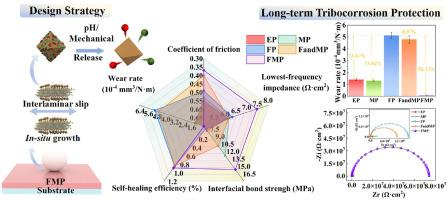Synergistic on-demand lubrication and corrosion inhibition: A pH/mechanical dual responsive MXene/MIL-100(Fe)-based epoxy coating for long-term tribocorrosion protection
IF 11.6
2区 材料科学
Q1 CHEMISTRY, PHYSICAL
引用次数: 0
Abstract
Critical moving components frequently encounter significant tribocorrosion challenges during service. Nevertheless, conventional protective coatings typically perform inadequately under wear-corrosion coupling conditions, exhibiting rapid degradation and concealed failure. Here, a high-performance filler (AR-FM) is synthesized by in-situ growth of MIL-100(Fe) nanocontainers on 2D transition metal carbides Ti3C2Tx MXene nanosheets, with the simultaneously encapsulating 5-amino-1,3,4-thiadiazole-2-thiol (AMT) and Rhodamine B (RhB). Subsequently, AR-FM is incorporated into an epoxy matrix to fabricate a smart protective coating (FMP). The tribocorrosion resistance of FMP with pH/mechanical dual-stimulus response and the relevant protective mechanisms are investigated through the combined use of experiments and molecular dynamics simulations. Under the tribocorrosion conditions, the wear rate of FMP (8.29 × 10−6 mm3/N·m) is one order of magnitude lower than that of the epoxy coating (EP), and its open-circuit potential remains a high level with minimal fluctuations (ΔVOCP < 0.005 V). When exposed to corrosive conditions, the complexation of released RhB with Fe3+ causes fluorescence quenching for self-warning, while the released AMT forms a passivation film at the damaged site, leading to the self-healing efficiency of 99.9 ± 0.05 %. The excellent tribocorrosion resistance is attributed to the synergistic effect of enduring MXene-based lubricating film, enhanced deformation resistance, strong interfacial bond strength, and efficient corrosion resistance with dual pH/mechanical stimulus response.

协同按需润滑和缓蚀:一种pH/机械双响应MXene/MIL-100(Fe)基环氧涂层,用于长期摩擦腐蚀保护
关键的运动部件在使用过程中经常遇到严重的摩擦腐蚀问题。然而,传统的保护涂层在磨损-腐蚀耦合条件下通常表现不佳,表现出快速降解和隐蔽性失效。本文通过在二维过渡金属碳化物Ti3C2Tx MXene纳米片上原位生长MIL-100(Fe)纳米容器,同时包封5-氨基-1,3,4-噻二唑-2-硫醇(AMT)和罗丹明B (RhB),合成了一种高性能填料AR-FM。随后,AR-FM加入到环氧树脂基体中,以制造智能保护涂层(FMP)。通过实验和分子动力学模拟相结合的方法,研究了具有pH/机械双刺激响应的FMP的耐摩擦腐蚀性能及其保护机制。在摩擦腐蚀条件下,FMP的磨损率(8.29 × 10−6 mm3/N·m)比环氧涂层(EP)低一个数量级,其开路电位保持较高水平,波动最小(ΔVOCP < 0.005 V)。在腐蚀条件下,释放的RhB与Fe3+的络合作用导致荧光猝灭,产生自报警作用,而释放的AMT在损伤部位形成钝化膜,自修复效率为99.9±0.05%。优异的耐摩擦腐蚀性能归因于持久的mxene基润滑膜、增强的抗变形能力、强的界面结合强度以及具有双pH/机械刺激响应的高效耐腐蚀性能的协同作用。
本文章由计算机程序翻译,如有差异,请以英文原文为准。
求助全文
约1分钟内获得全文
求助全文
来源期刊

Carbon
工程技术-材料科学:综合
CiteScore
20.80
自引率
7.30%
发文量
0
审稿时长
23 days
期刊介绍:
The journal Carbon is an international multidisciplinary forum for communicating scientific advances in the field of carbon materials. It reports new findings related to the formation, structure, properties, behaviors, and technological applications of carbons. Carbons are a broad class of ordered or disordered solid phases composed primarily of elemental carbon, including but not limited to carbon black, carbon fibers and filaments, carbon nanotubes, diamond and diamond-like carbon, fullerenes, glassy carbon, graphite, graphene, graphene-oxide, porous carbons, pyrolytic carbon, and other sp2 and non-sp2 hybridized carbon systems. Carbon is the companion title to the open access journal Carbon Trends. Relevant application areas for carbon materials include biology and medicine, catalysis, electronic, optoelectronic, spintronic, high-frequency, and photonic devices, energy storage and conversion systems, environmental applications and water treatment, smart materials and systems, and structural and thermal applications.
 求助内容:
求助内容: 应助结果提醒方式:
应助结果提醒方式:


